Elephant Butte Lake visitor guide: when to visit, where to fish, camp and more
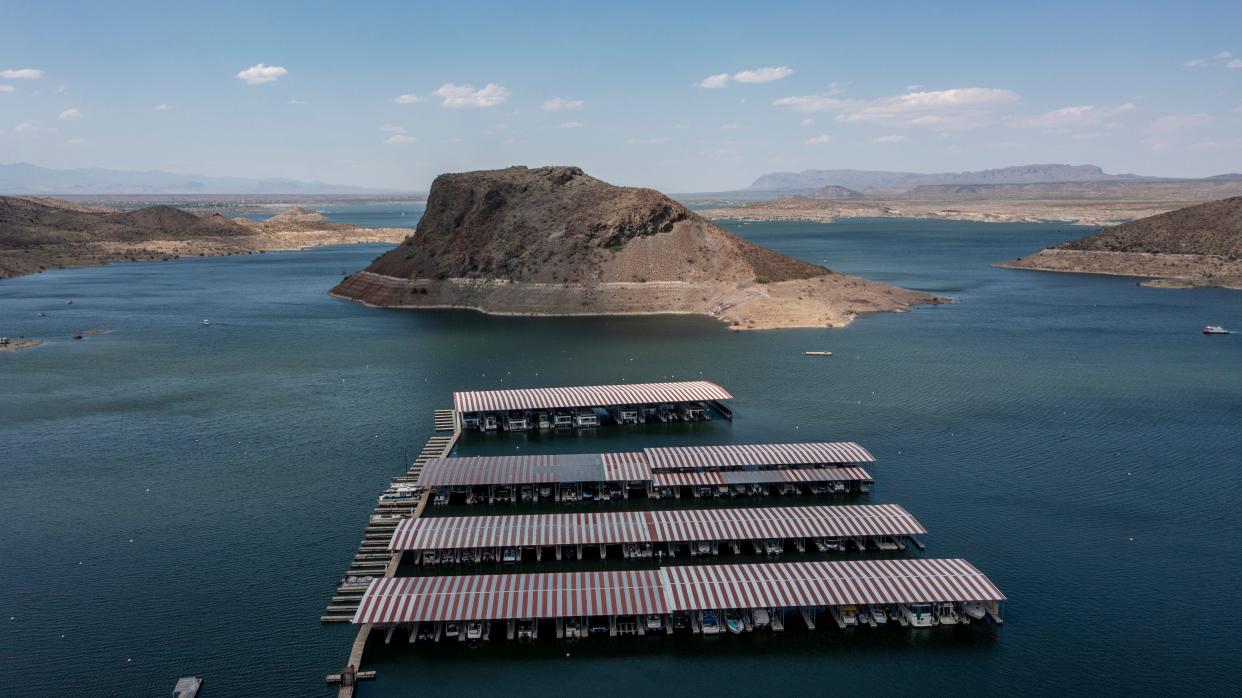
ELEPHANT BUTTE, N.M. — With a little imagination, the flat-topped butte protruding from the dammed waters of the Rio Grande in Sierra County, is said to resemble an elephant.
Resemblant or not, Elephant Butte is iconic, the namesake of a town, dam and lake — "the largest body of water within 500 miles," said Chris Bolen, the superintendent of Elephant Butte State Park.
Two hours from both El Paso and Albuquerque, the state park offers year-round boating, swimming, fishing, hunting, hiking and more to outdoor enthusiasts. But increasingly hot and dry summers are posing challenges that officials at the state park and dam are learning to deal with.
Here's everything you need to know about visiting Elephant Butte Lake — from where to rent a pontoon boat and where you can camp to when water levels will be the highest.
When is the best time of year to visit Elephant Butte?
Elephant Butte Lake is north of Truth or Consequences, just off Interstate 25. It is easily accessible from both El Paso and Albuquerque but draws visitors from all over the region and world.
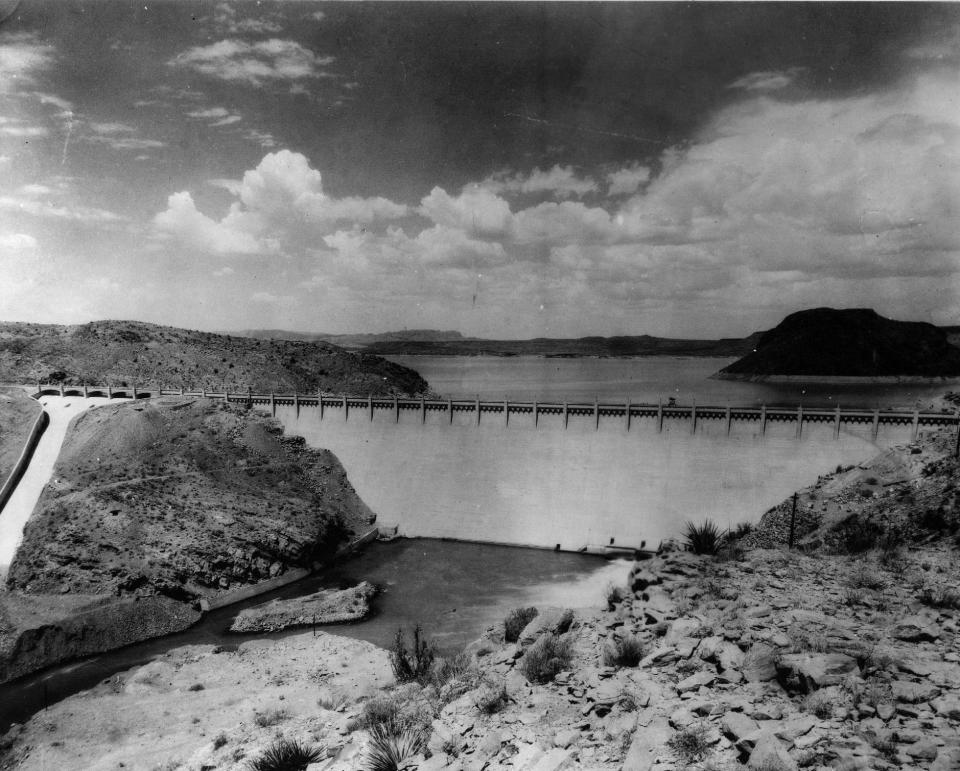
The day-use fee is $5, and an annual day-use pass is $40 for all New Mexico state parks.
On weekends, especially during the summer peak season, the park is packed with visitors. Boat rentals and campsites may be sold out.
Labor Day weekend in 2023, the park hosted 26,019 visitors. On other holiday weekends like Memorial Day and July 4, visitors have historically reached 100,000 on each day. Yearly visitation has at times reached one million, Bolen added.
Regulars like John and Shelley Davis from Rio Rancho have been coming for most of their lives and know to come on weekdays to avoid crowds.
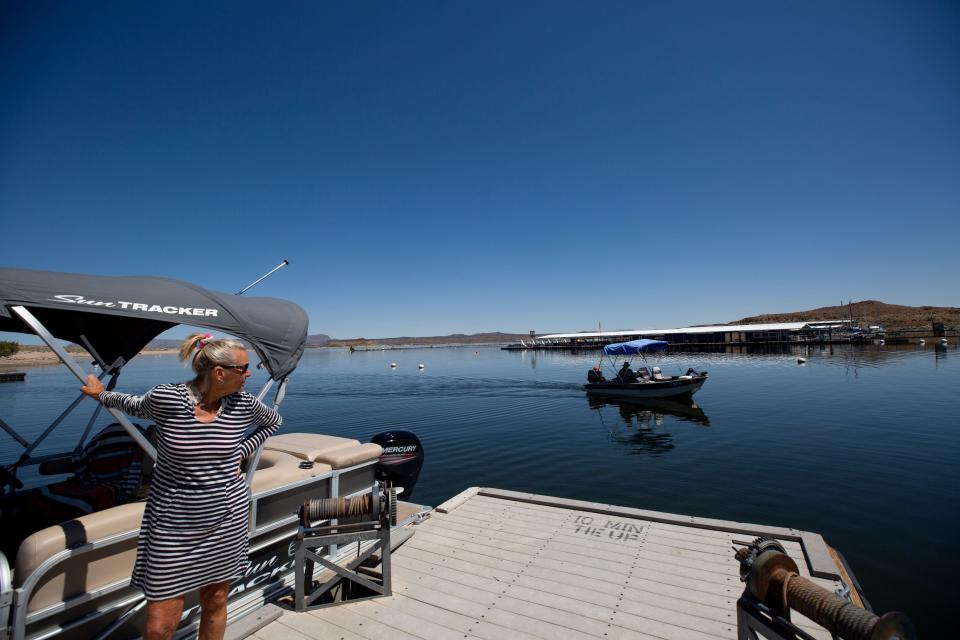
"Today, they have the lake basically to themselves," said Bolen, watching the couple smoothly launch a pontoon boat into the lake on the Wednesday after Labor Day. "They can get out there and probably not see another boat."
Elephant Butte water level
Much of the activity at Elephant Butte State Park, including boating, where you can drive and which marinas are operational, depends on the lake's water levels.
"Everybody says, 'What's the lake level?' It's always relative, every time you see it," Bolen explained.
The lake is manmade by a dam across the Rio Grande, completed in 1916. The Bureau of Reclamation uses it to regulate water dispersal for irrigation.
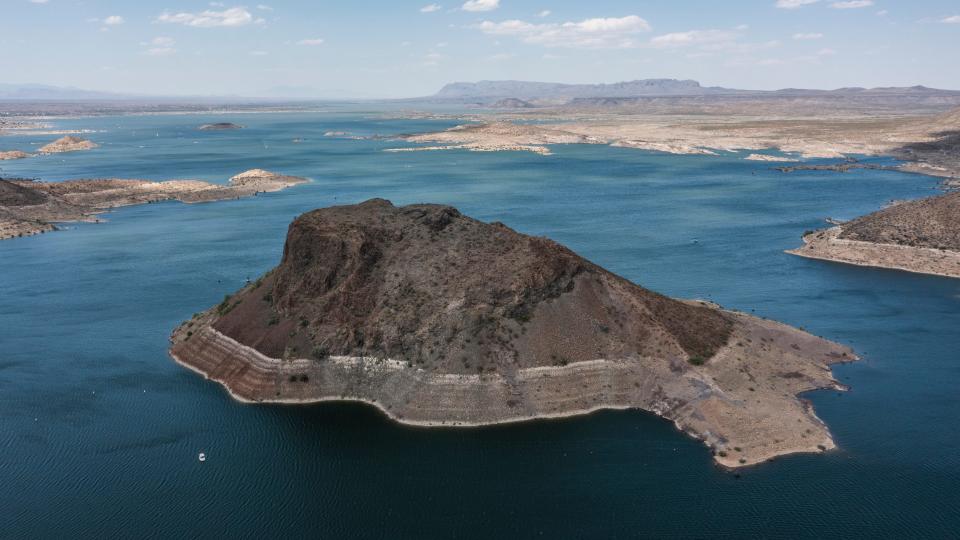
To counteract dry summer months, the dam releases certain amounts of water between May and October. The water then enters Caballo Lake — another dam-formed lake and state park 18 miles south of Elephant Butte — and is then directed for irrigation in New Mexico.
The Rio Grande is fed by snowmelt at its source in the Rocky Mountains and rainfall from the summer monsoon season. But with drier summers, delayed monsoons and intense heat, lake levels are scraping lower and lower.
During summer 2022, water levels in the lake reached 3% capacity — the lowest Bolen had ever seen in his 24-year career at Elephant Butte. "But a really great monsoon season and a really great run-off" helped bring the lake back to more manageable levels, Bolen said.
As of May 23, water levels were hovering around 23% full. Exactly one year before, it was around 26%.
Water data in the Elephant Butte Lake is publicly available online.
Within the state park, "we have to plan for the water level," he continued, indicating a chart hanging on his wall with predictions of water release rates, river flow and lake levels from the Bureau of Reclamation. "We have to make sure our buoys are in place, the ramps are good to go and we can move our docks up and down," Bolen said.
Driving through the park, Bolen pointed out many signs of historic high-water levels, like the white bathtub ring around the lakeshore, mesquite trees among smaller desert shrubs and one-time waterfront houses that have since become just beachfront property.
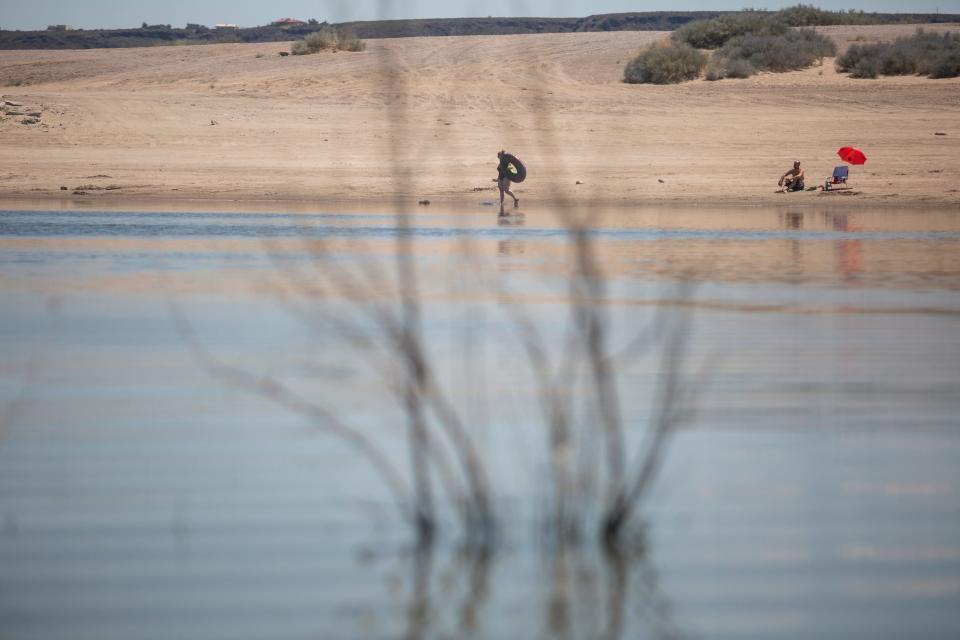
There is also evidence of past low-water events, like a paved road now crumbling into the lake. "They thought the water was going to be low for so long, they built some roads," Bolen explained.
"It gets interesting when it rains hard," Bolen said. Lake levels rise dramatically, roads wash out and sand, silt and mud move freely.
With that wisdom, Bolen now is intent on building manageable infrastructure like new bridges and culverts that won't be washed away by fluctuating water levels. "We don't want to build anything beneath the high-water mark, especially anything permanent," he said.
All these calculations and preparations to keep the park running and accessible for hundreds of thousands amount to a daunting task. But for Bolen, "it's just part of the job."
Camping at Elephant Butte
Campers have a wide array of options at Elephant Butte — and the unique freedom to park RVs as close to the water as possible.
"Drive down here, find your little spot at the beach and go for it," Bolen said, driving past a pristine, empty stretch of lakefront beach.
There are also more traditional campsites that range in price from $8-18 a night.

While some sites have plug-ins and hook-ups for RVs, providing electricity and water (but no sewer service), sites without electricity still offer much. At sheltered sites along Ridge Road, overlooking the lake from the west, "you get your shade, you get your picnic table, you get your fire ring and you get a heck of a view in the morning.
Sites can be booked through reserveamerica.com.
Can you visit Elephant Butte in the winter?
There is no off-season at Elephant Butte. "We just call it the slow season, and that's the wintertime," Bolen said. "The water temperature goes down, and the fish aren't as active."
But winter at Elephant Butte appeals to a different type of visitor. Birders come out to see migratory waterfowl — bald eagles, white pelicans from the Great Lakes, ducks and Canadian geese — that move to New Mexico for the winter.
Elephant Butte also has snowbirds of a different feather — retirees and campers from out of state who spend their winters happily in the warmth of the desert. Some services in the park and nearby towns may be closed or operate with limited capacity in the winter.
More: 1916: Elephant Butte Dam dedicated 100 years ago
Marinas at Elephant Butte
Boaters can store their boats at two marinas on Elephant Butte Lake, both operated by private concessioners.
The Dam Site Marina is the largest and southernmost marina on the lake, in part of the lake owned and operated by the Bureau of Reclamation. It is managed by the Dam Site Historic District.
Marina Del Sur is centrally located by the main entrance to the state park.
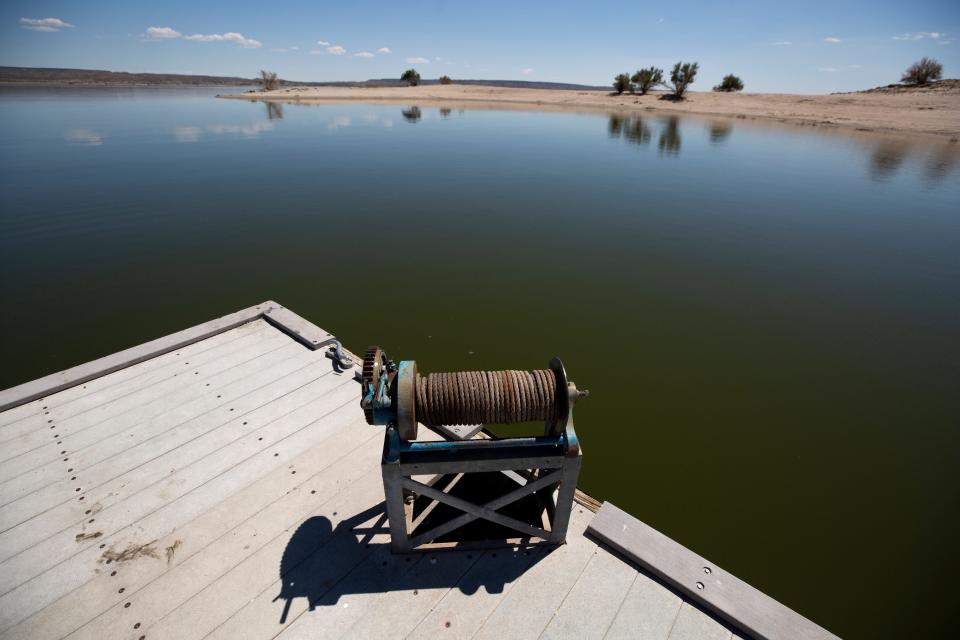
Sports Adventure, a marina at Long Point, is closed indefinitely due to low water levels in the lake. After historically low lake levels last year, "this year they couldn't afford to … get it up and running without some certainty if the water is going to be there," Bolen said.
Both functional marinas offer covered and uncovered slips of varying sizes, as well as jet ski ports.
Boat rentals at Elephant Butte
If you don't own a boat, rentals at Elephant Butte State Park are available at the two open marinas, at select other locations across the park and in nearby Truth or Consequences.
You must be 21 with a valid driver's license to rent a motorboat, although kayaks and stand-up paddleboards are also available.
Boat rentals of all kinds are extremely popular. "It's not unusual for us to sell out on the weekends," said Bolen.
The Dam Site Marina has house-boat slips, regular boat slips, a store and kayak and stand-up paddleboard rentals.
Marina Del Sur has boat slips and also offers a fleet of pontoon boats and kayaks for rental. The baseline option at Marina Del Sur is $300 for a 12-person pontoon boat for a minimum of 3 hours on the lake.
Within the park, a concessioner also operates a jet ski rental at Hot Springs Landing.
Boating rules in Elephant Butte Lake
"Boats break down. It's just inevitable," Bolen said. "If your boat hasn't broken down, you haven't been doing it long enough."
Park rangers are on alert to help rescue boaters and tow boats to shore. But the burden also falls on the boater to be prepared.
"Anyone born after Jan. 1, 1989, must complete a New Mexico-approved boater education class in order to operate a power boat in New Mexico," Bolen said. "Those are offered free of charge at any of our lake parks, also in Albuquerque and online." (Those born before Jan. 1, 1989, are grandfathered in and are not required to take the boater education class.)
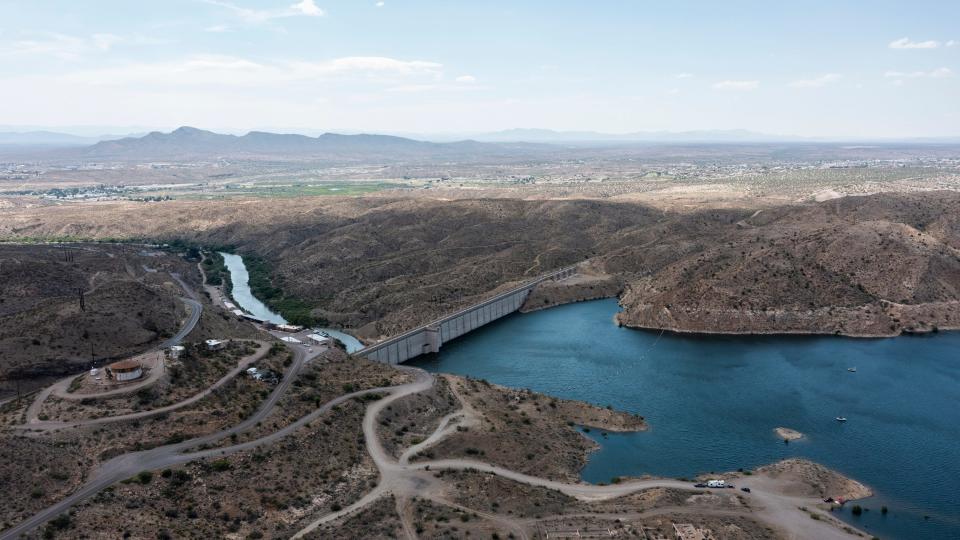
Elephant Butte State Park offers free boating safety courses one Saturday each month at the Richard Cooper Boat Safety Training Center near the main entrance gate on Highway 195. "It's like a driver's-ed class for boats," Bolen said.
Boaters who are renting from one of the park's marinas are exempt from these in-depth, eight-hour courses. "The marina is going to give you a quick, down and dirty safety course, give you information on boating safety and then turn you loose," Bolen added.
Vessels are also inspected for aquatic invasive species upon entrance to the park. If a boat has standing water from another lake or species like zebra mussels growing on it, park staff will treat the boat to reduce the risk of speaking invasive species.
Facts about Elephant Butte fishing and hunting
Aboard your boat or standing on the shore, fishing is allowed anywhere on the lake except the marinas and the boat docks with a New Mexico fishing license, which can be purchased online or in person.
Fishers can eat what they catch and cook their catches on the grills at campsites. There are no health concerns about fish from the lake, Bolen said.
Elephant Butte Lake boasts the New Mexico state record for green sunfish, striped bass and longear sunfish.
Beyond record breakers, the lake is rife with many types of fish, including "black, white, and striped bass, as well as crappie and bluegill."
"I've seen kids, just dinking around, pull in beautiful black bass that some of these tournament fishermen would give their left knee for," Bolen said.
The portions of the park where hunting is allowed vary by year, but the northern and easternmost edges of the lake and shore typically compose the designated hunting area. With a valid state license, hunters can pursue mule deer and waterfowl like ducks.
How to swim and hike in Elephant Butte State Park
"We do not have a designated swimming area," said Bolen. "You can swim anywhere at your own risk."
For hiking, the park hosts a 20-mile West Lakeshore Trail from the city limits of Elephant Butte to the Monticello campground along the northern shore of the lake. A map of the trail, which features benches, signposts and some steep sections, is available on the state park website.
Bolen noted that this stretch will hopefully one day link with the Rio Grande Trail, a proposed trail along the length of the river, from Colorado through all of New Mexico, ending in El Paso.
This article originally appeared on El Paso Times: When to visit, where to fish, camp and more at Elephant Butte Lake